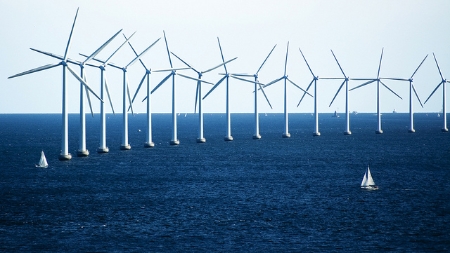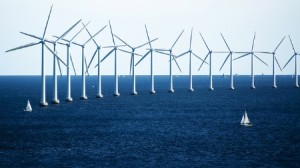As most readers are aware, the first major U.S. offshore wind farm to begin development was the Cape Wind project in Massachusetts. The project has been in the development phase for over a decade. The major barriers to development have been public opposition as well as the lack of an established regulatory framework with which to manage offshore energy development in the U.S.
In April, Secretary of the Interior Ken Salazar signed off on Cape Wind’s construction and operations plan. Construction, however, has not yet begun. As of this writing, Cape Wind still needed to sign a power purchase agreement (PPA) for 50 percent of the project’s output. A signed PPA will likely be needed to obtain financing. Even with signed PPAs for 100 percent of the power, obtaining financing will not be an easy process due to the offshore-specific risks involved with the project and the prospect of being a first-mover.

With thousands of megawatts of proposed offshore wind projects in the U.S., billions of dollars will be needed to finance them. The question then arises, “where is the money going to come from?”
At a high-level, there are two methods with which to finance offshore wind projects. The first is corporate finance or on-balance sheet financing. In this case, the project developer uses its own cash and/or debt secured against the assets of the company as a whole. The second method is to use project finance. Here, the developer typically establishes a stand-alone entity and secures financing based solely on the cash flows of the project. There are trade-offs with both methods.
Debt raised with balance sheet financing is cheaper as the overall risk of the company is less than that of the specific offshore project. Balance sheet financing involves fewer parties, thus saving time, and allows the developer to maintain greater control over the project. The major drawbacks include the capital intensiveness and the exposure of the company to the full risk of the project.
Project finance reduces the amount of capital needed from the project sponsor and insulates the sponsor from the project’s failure, but is typically more expensive and difficult to arrange given the number of parties involved and the amount of due diligence required.
In anticipating how offshore projects will be financed in the U.S., it is useful to turn to Europe as, at the end of 2010, more than 95 percent of global cumulative installed offshore wind capacity was located in Europe. In recent years, most European offshore wind farms have been financed on the balance sheets of major European utilities such as Dong Energy, Vattenfall, Scottish & Southern Energy (SSE) and E.ON.
The reasons for this include the lack of project finance availability due to the credit crisis and the perceived risks of offshore by many in the market. As noted above, however, this strategy has its downside. As European utilities increase their capital expenditures to fund the multi-billion-dollar offshore market, as well as other infrastructure projects, their corporate ratings are coming under pressure. In the U.S., no utility has appeared willing to finance an offshore wind farm on its balance sheet. U.S. offshore developers are unlikely to self-finance projects, so they will need access to project finance.
In non-recourse project finance, lenders base their decisions on the expected cash flows of the individual project, so they will need confidence in the assumptions about cash inflows and outflows.
The most significant cash inflows for offshore wind farms are those for power sales. Without a long-term power purchase agreement (PPA), offshore wind farms in the U.S. are unlikely to obtain financing. In addition to Cape Wind, two other U.S.-based offshore projects have signed PPAs. In 2008, NRG Bluewater Wind signed a 25-year PPA with Delmarva for up to 200 MW. In 2009, Deepwater Wind and National Grid signed a 20-year PPA for the former’s 28.8-MW project off of Rhode Island.
All of these PPAs, however, have come under tremendous scrutiny for the increased rates electricity customers would pay. As the cost of energy from offshore wind farms can exceed typical power prices in the Northeast, some states are trying either to improve the economics through incentives or mandating that utilities sign PPAs for offshore wind.
Another key aspect for financiers in terms of cash inflows is ensuring the uptime of the wind turbines. When turbines are not spinning, the wind farm owner is not generating revenue. Potential lenders want to limit “volume” risk. The best way to do this is to utilize turbine models with a history of strong operating performance. To date, the most tested turbines in operation are the Siemens 2.3-MW and 3.6-MW designs as well as Vestas‘ 3.0-MW model. Cape Wind has signed an agreement with Siemens for 130 of its 3.6 MW turbines, a decision that will put financiers at ease in terms of technology risk.
In addition to the technology/operating risk involved with turbine selection, weather risk is also a key concern. Severe weather such as hurricanes can put turbines out of service and also inhibit access to maintain and repair turbines. As such, projects sited in the Southeast and Gulf of Mexico are likely to receive greater scrutiny during the due diligence phase.
On the cash outflow side, the principal risk is related to construction. The relative immaturity of the offshore wind sector can lead to considerable delays and cost overruns. Most U.S. offshore wind farms under development are located in federal waters, which are deeper. While this will reduce visual impacts and, thus, public opposition, it may also require foundation types that are less proven in the industry, as compared to monopiles.
This, along with potential supply chain constraints, inclement weather and coordination issues with multiple contractors, can put the project’s cash outflows at considerable risk. That said, project financiers, based on their experience in the European market, will painstakingly ensure that all steps have been taken to mitigate these risks.
For larger projects, the support of government or quasi-government agencies will likely be critical either in terms of loans or loan guarantees. Most offshore projects that have been project financed in Europe have received support from some combination of the European Investment Bank (EIB), the Danish export credit agency, Eksport Kredit Fonden (EKF) and the German export credit agency, Euler Hermes (EH). The export credit agencies could facilitate the financing of U.S.-based projects by supporting turbine manufacturers such as Vestas, Siemens and REpower.
In terms of U.S.-based institutions, the Department of Energy loan guarantee program once appeared to be a major source of financial support for the U.S. offshore wind market. The current outlook, however, is quite bleak due to lack of funding. In mid-May, the DOE notified Cape Wind that its loan guarantee application had been put on hold. The Cape Wind leadership has indicated that the project could survive without the loan guarantee, but that the guarantee would increase the project’s viability significantly. In late May, NRG Bluewater put a project on hold, with a company spokeswoman saying, “The abrupt reduction of DOE loan-guarantee authority has injected considerable uncertainty into the financing for and viability of all U.S. offshore wind projects.”
In spite of the lack of a loan guarantee from the DOE for Cape Wind, Siemens has stepped in to potentially save the day by offering debt and equity financing for the project. In late June, its CFO, Josef Kaeser, indicated, “We’ve always made it clear that we are not only willing but also capable of helping to support the whole project.” While Siemens may finance the Cape Wind project, the OEM-financed paradigm is unlikely to be a typical financing model over the long-term. That said, some OEMs may finance select projects to ensure the sale of their turbines.
To date, the most publicized aspect of the U.S. offshore wind market has been the arduous nature of regulatory hurdles. As clearer regulatory processes have been put in place, more developers have begun developing offshore projects. Even with support from the public, from the Bureau of Ocean Energy Management, Regulation and Enforcement and from state governments, offshore wind projects in the U.S. are far from a slam dunk. Challenging project economics and uncertainty around project risks will complicate project financing and will likely constrain growth in the coming years. These challenges, however, also present the opportunity for project developers, government agencies and financiers to develop innovative financing approaches.

 Follow
Follow